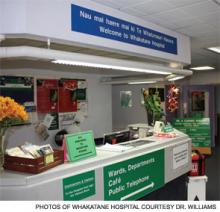Every hospitalist has worked with an electronic health record (EHR) in one form or another, but one of the most frustrating things in the States is the lack of interface between EHR in different health systems. Such disconnect leads to an extraordinary amount of effort not to duplicate tests for patients who frequent more than one hospital. Often, these patients are high consumers of healthcare at baseline, and duplicating tests only makes it worse.
New Zealand has one computer system that allows the GPs and the hospitalists to view all the labs and imaging results together, in the same system. No matter who orders the test, it all comes back to the same place. It might seem small, but it makes a tremendous difference to the management of the patient. One could argue that defensive medicine is good practice, but we’ve all seen the extra study get ordered somewhere along the line. I won’t get into the details of malpractice insurance (the editors said stop at 2,000 words, and I could go on for 200,000), but back home in Colorado, I paid about $20,000 a year for malpractice insurance. Here, it’s $1,200.
New Zealand has a no-fault compensation system in which injured patients apply for government-funded compensation and thus give up the right to litigation. Most claims are processed within weeks, and all decisions are final within nine months. The patients here know that they have recourse for a bad outcome, and the physicians practice in a manner according to clinical judgment, rather than trying to avoid being sued.
Confusion and Delay
You might get the sense that practicing medicine in New Zealand has been a refreshing change of pace, and you would be right. My physical exam skills (what was left of them) are starting to return. I think long and hard before ordering an imaging study or requesting consultation. I order antibiotics according to the guidelines. I only prescribe medicines that are on the formulary. The care given to the patients by the staff and the knowledge exhibited by our physicians are quite good.
Still, this system is by no means perfect. The delays in care can be excruciating in both the urgent and routine settings. For example, my first patient on my first day of work had an acute myocardial infarction. The ED physician admitted him to the hospital at midnight, but no one on our team had met the patient when I arrived for work the next day. At 8 a.m., he had dynamic EKG changes, a positive troponin, ongoing chest pain, and a systolic BP of about 90 mm/HG. Back home, I never would have met the man, as he would have gone pretty much straight to the cath lab—with the cardiologists—within 60 minutes, even at midnight. Here, we had to call the hospital that does interventions, arrange a bed (hoping one was available), then put him in an ambulance for a four-hour drive on a two-lane road to receive a stent for his 100% coronary lesion.
The average wait for transfer for acute coronary angiography is about five days. The average wait for routine outpatient echocardiography is two years. Yes, two years.
Ultimately, the right thing gets done, but sometimes way too slowly. Thus, there is a smaller, parallel private insurance system, but people view it as optional and only use it when they want to speed up the schedule.
